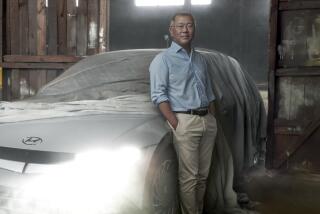Hyundai Sedan May Be Vehicle for Change
- Share via
Hyundai Motor America, enjoying its best sales in a decade, plans to bring a near-luxury sedan to the U.S. by the end of next year, company President Finbarr O’Neill has confirmed.
The long-discussed move would give the Fountain Valley-based importer an important “move-up” vehicle beyond its current lineup of small and mid-size cars while helping its parent, Seoul-based Hyundai Motor Corp., maintain sales volume that it has lost because of South Korea’s economic woes.
The five-passenger car, code-named the XG, would be built on the same platform Hyundai uses in South Korea for its flagship Grandeur sedan and would be about the same size as Toyota Motor Corp.’s Avalon. It is likely to be powered by the 3.0-liter, 200-horsepower V-6 engine now used in South Korea.
Although there is no clearly demonstrated clamor for a bigger Hyundai--analysts say the XG would be in an especially competitive market segment--it could help attract price-conscious customers who seek more car than the company offers with its present lineup.
With pricing expected to start at about $23,000--including leather seat covers, air conditioning and automatic transmission as standard equipment--the XG would be among the least expensive in its class.
Hyundai also will enter the crowded U.S. market for sport-utility vehicles in the spring with the previously announced Santa Fe, about the size of Ford Motor Co.’s Explorer.
Ultimately, Hyundai could add a full-size luxury car, a van and another, larger SUV to its U.S. lineup as part of its efforts to create new markets for vehicles it already sells in South Korea, said analyst George Peterson, president of AutoPacific Inc. in Tustin.
“This is a market they need in order to help [sales] while the Korean market is damaged,” he said.
Despite unsettled economic conditions at home, Hyundai appears to be staging something of a comeback in the U.S. this year after nearly a decade of lackluster sales resulting from a ruinous reputation for poor quality.
The company reinvented the economy car market in the U.S. with its $4,995 subcompact Excel in 1986, which went on to set import sales records in 1987 and ’88. But South Korean executives failed to listen to warnings from their American unit’s managers that U.S. consumers demanded a high level of quality and reliability even from entry-level vehicles.
In a rush to meet demand for the inexpensive cars, Hyundai sent underpowered vehicles with inadequate cooling and brake systems to the U.S. Sales plummeted when problems began developing as the cars started wearing out prematurely.
In recent years, however, Hyundai has improved the engineering and design of its vehicles as well as quality control at its factories in South Korea. After losing a number of top U.S. executives who expressed frustration over their inability to wrest control from Korean corporate officials, Hyundai promised O’Neill a large measure of autonomy when the former corporate counsel was asked to take on the presidency a year ago.
To promote its new commitment to reliability, Hyundai began offering an unprecedented 10-year, all-encompassing warranty in 1998 and has advertised it heavily. The warranty not only helped boost sales, O’Neill said, but it also brought more credit-worthy customers to Hyundai showrooms, improving dealers’ profits and their willingness to promote the company’s cars. Most Hyundai dealers hold several franchises, often selling competing brands from the same facility.
Through Sept. 30, Hyundai had sold 106,736 vehicles in the U.S., a gain of 68% in a market that has seen total sales jump by about 10%.
The near-luxury sedan “will be an interesting addition to the line” that will test how well Hyundai has done with its image improvement campaign in the U.S, AutoPacific analyst Peterson said. Annual sales of the sedans could hit 12,000 to 15,000 units in the first few years if Hyundai can continue to rebuild goodwill among buyers, Peterson said.
O’Neill, who disclosed plans for the near-luxury model last week during a press preview of Hyundai’s 2000 Accent subcompact, said the XG would be positioned to compete with other near-luxury import sedans such as the Avalon and Nissan Motor Co.’s Maxima.
Peterson, who has driven the XG in South Korea, likens it to General Motors Corp.’s Buick Century.
“It has a lot of nice features, and the quality is good,” he said. “It will be an outstanding value for the money.”





